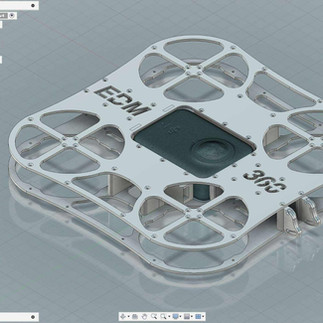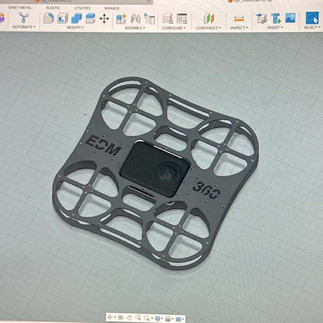
Flying Beyond Racing: Steath’s Cinematic 360 Frame
1
48
0
From the high-speed world of FPV racing to the precision of cinematic flight, Edward “Steath” Dalton is redefining what it means to be a drone pilot. Once known for tearing through gates on the British FPV circuit, Steath has shifted his focus toward film — building his own cinematic drones and pioneering a new, compact design tailored for the DJI Osmo 360 Action Camera.
From Racing Lines to Cinematic Storylines
Edward has been an FPV racer competing at the highest level in the UK for several seasons. Notably achieving 2nd overall in the 2025 UK Drone Racing League and travelling internationally to compete amongst 140 of the worlds top pilots in Riyadh World Cup Race where he came 24th - an incredible achievement given the terrible video the event suffered.

But his vision is wider than racing. This idea came to Steath during a mountain biking trip in France. Scrolling through social media on a ski lift, he spotted DJI’s new 360° camera — small, sleek, and full of potential.
“I’d seen all these 360 drones... and I was like, they’ve got to be impractical surely — you can’t use that in a tight space. So {I thought}, how small can I get a drone with a 360 camera on it? And I just went for it because... nobody's made one for this camera.”
That spark of inspiration led to the Steath 360 Frame — a lightweight, purpose-built FPV drone frame designed to give creators true 360° freedom. The challenge? Making it small, quiet, and cinematic — all without the frame showing up in the footage.
Engineering a Vision
Getting there wasn’t easy. Over the course of several months, Steath went through ten to twelve prototypes, testing variations in propeller size, camera placement, and battery layout to eliminate unwanted frame edges from view.
But this project is not just part time in his shed. The design skills and process of development is supporting his education at Sixth Form. Having real world experience using the product he is flying means the learning is real and the product is useful.
Disclaimer: All designs and photos shown in this article have been supplied by Edward Dalton, are his own work, and remain his property.
Using laser cut plywood to check for fit and clearance, is a quick way to find out problems in the real world without comitting to the high cost of carbon fibre. Once its been assembly tested, he sends his final designs to fellow FPV pilot, Hairy Haggis, who has a CNC machine to cut each carbon fibre prototype to order. This has allowed Steath to iterate fast — sometimes turning around a new frame in just three days.
“...you’re trying to find the balance... because the camera takes up so much space in the middle. You’re trying to get {the props} as tight as possible just because of the size. I want this to be able to fit through like a nice doorway without being too big and heavy... not turn up to a real estate shoot and the guy goes, ‘you fly that?’”
His latest version, equipped with 3.5-inch props, delivers smoother footage and quieter flight — a key requirement when filming at public events.

Flying Under the Radar
While racing taught him precision and control, cinematic flying demanded something new — subtlety.
“Half the battle as a cinematic pilot... is you literally {have to} stay low-key the whole time. You don’t want to be seen.”
He recalls one early shoot where onlookers questioned his flight permissions mid-scene.
“You can’t have someone coming over like, ‘are you flying that?’ and by then you’ve missed the shot. So, I just go hide in the corner.”
At events like Modified Nationals and The Evans Cycles Lake Ride, Steath’s workflow has become almost military in its efficiency. With help from his dad on battery swaps, he’s able to keep the drone airborne between shots, capturing dynamic moments as they unfold.
“My dad would come to all these events... I’d land it where he was, he’d have the batteries and he literally whipped one out his pocket, plugged it in, and then I’d go again.”
The Sub-250 Frontier
With new UK drone regulations coming into force, Steath is already designing sub-250g drones that remain legal to fly near people and crowds without complex permissions.
“Without getting a GVC... you can't apply for an operational authorisation {to fly with less restrictions} which only lasts a year to fly anything over 250 grams in the A2 category. So, I was like right, I’m not gonna bother with that... I’m just gonna design sub-250 drones.”
One concept includes a servo-tilt camera system that allows him to dynamically adjust the lens angle mid-flight — ideal for motocross, mountain biking, and drift car chases.
“We’d be speeding up and {then} they’d slow down and you’d lose them. So, I was like, I need something that tilts.”
Producing multiple drone frame concepts, bespoke for each scenario means Steath can always get the best shot. His recent experience with OnAir.Link calls for another version aimed at integrating live-streaming FPV, opening the door to real-time coverage of high-speed events.
“I’m hoping that company {OnAir.Link} will want to work with me a bit more... and if I got called back, I’d be able to bring this {new tilting camera drone} and go, look — this one’s gonna hopefully fly for like 15 minutes or something.”
Cinematic Ambitions
Despite his engineering focus, Steath’s true motivation is storytelling. His next big project is a showreel, currently in post-production and set for release later this year.
“I’d really like to end up doing something cool like that. That’s the goal — end up doing something I’m really, really proud of.”
Between balancing A-Levels and late-night design sessions in Fusion 360, Steath is working to prove that passion can become a profession.
“Ideally I don’t want to go to Uni or do any of that. I really don’t want to end up in an office. I just want to be able to prove to myself that I can do it... and hopefully scale it to something that’s quite big.”
Reframing FPV
For Steath, cinematic FPV isn’t just about capturing motion — it’s about changing perceptions. When presenting his drone project to his school’s design teacher, he summed up his reasoning perfectly:
“He said, ‘why would you use an FPV drone over something else in a production?’ and I just went — it’s always cheaper than a helicopter.”
That perspective — part humour, part truth — sums up his mission: to show how FPV can be creative, accessible, and cinematic, not just fast.
With his Steath 360 Frame, Edward Dalton is helping to redefine what’s possible in aerial storytelling — one quiet, seamless flight at a time.


































